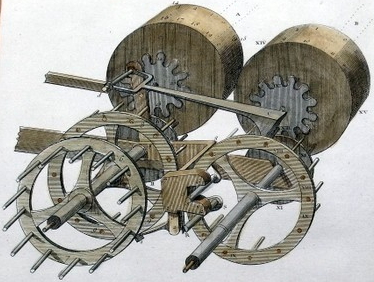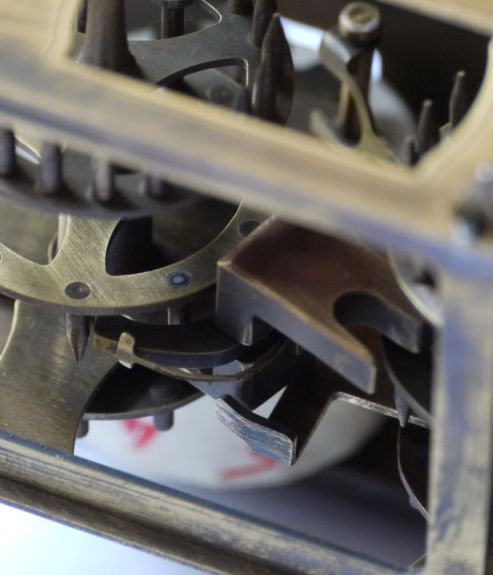
This beautiful version of a Pascaline was fashioned with great dedication and craftsmanship by Jan Meyer from brass and mahogany. The task of building this, together with three copies, took him hundreds of hours over two full years. It is not a replica of any particular surviving machine, but rather, a working exemplar which takes as its task to demonstrate that if the principles of the Pascaline are followed faithfully by a dedicated artisan, using the same sorts of materials and techniques, but with the capabilities of a modern workshop, the resulting hand made machine (with its entire mechanism, including its carry mechanism, following that embodied in surviving machines and historical records) will work reliably and smoothly. The resulting replica is a re-creation very much in the style of the surviving Queen of Sweden Pascaline but also of the “tardive” Pascaline held by the CNAM (Conservatoire National des Arts et Métiers) in Paris. It also has some elements of the surviving “Queen of Poland Pascaline” held in Dresden1. As with the Queen of Sweden Pascaline this is a “scientific Pascaline” in contrast to most others of the surviving Pascalines (including the Tardive and that at Dresden) which are “accounting Pascalines” configured to add the currency of the period. (A subsequent replica by Jan Meyer - of the “Queen of Poland” Pascaline - is also held in this collection.)
The carry mechanism is the classical “sautoir” as described by Diderot and d’Alembert2. It consists of a weighted metal fork with a lever and spring. As the first gear (say the units wheel) is rotated from 0 to 9 the fork is lifted and is then released as the gear passes from 9 to 0. As the weighted fork falls the attached lever pushes the spoke of the next gear (the tens) to rotate that gear by one unit. Thus unlike the Schickard which relied on single rotation from 0 to 9 to make all necessary carries along a row of gears (which proves impossible if more than 3 or 4 must be moved at once), Pascal used his sautoirs to store potential energy by lifting a weight (the fork) as each gear rotated from 0–9. That stored energy was then ready to rotate the next gear by one unit when the time came for the sautoir to fall causing the next gear to rotate forward by one unit. For more detail on the mechanism of the Pascaline click here.
 |  |
| Carry Mechanism (sautoir) from Diderot3 (collection Calculant) | as recreated in collection Calculant |
(Click on photos to enlarge)
| Mini: PHP-GD image library not found. Exiting.
Top view | Mini: PHP-GD image library not found. Exiting.
Input wheels | Mini: PHP-GD image library not found. Exiting.
Chasis and | Mini: PHP-GD image library not found. Exiting.
Bottom as for | Mini: PHP-GD image library not found. Exiting.
Mechanism |
| Mini: PHP-GD image library not found. Exiting.
Sliding panel | Mini: PHP-GD image library not found. Exiting.
Stop bar on | Mini: PHP-GD image library not found. Exiting.
Input stylus | Mini: PHP-GD image library not found. Exiting.
Base and | Mini: PHP-GD image library not found. Exiting.
Inner |
| Mini: PHP-GD image library not found. Exiting.
Output | Mini: PHP-GD image library not found. Exiting.
Inscription | Mini: PHP-GD image library not found. Exiting.
Bottom | Mini: PHP-GD image library not found. Exiting.
Corner catches | Mini: PHP-GD image library not found. Exiting.
Engraved coat |
Other information provided in this site includes subsequent replica by Jan Meyer - of the “Queen of Poland” Pascaline, Operating Instructions for a Pascaline, 1759 diagram, Pascal’s original “avis nécessaire” pamphlet and other historical diagrams of the mechanism and details of surviving Pascalines and other exemplar and replica Pascalines.
1 Together with some minor internal mechanical design variations, most notably the ratcheting “pawls” are slightly offset from their usual position. (↑)
2 Denis Diderot and Jean le Rond d’Alembert, Encyclopédie ou Dictionnaire raisonné des sciences, des arts et des métiers, par une Société de Gens de lettres, 1ere edition, vol. 1, 1751: see also Denis Diderot and Jean le Rond d’Alembert, Encyclopédie, ou dictionnaire raisonné des sciences, des arts et des métiers, etc., eds. University of Chicago: ARTFL Encyclopédie Project, Spring 2013 Edition, Robert Morrissey (ed), http://encyclopedie.uchicago.edu/., viewed 12 July 2013; and in particular http://encyclopedie.uchicago.edu/.vol. 1, p. 680 http://artflsrv02.uchicago.edu/cgi-bin/philologic/getobject.pl?c.0:2906:6.encyclopedie0513.7646494, viewed 12 July 2013, and page from Diderot in this collection (see below) (↑)
3 Denis Diderot and Jean le Rond d’Alembert, “Algebre et Arithmetique - Machine de Arithmetique de Pascal”, Encyclopédie ou Dictionnaire raisonné des sciences, des arts et des métiers, First folio edition, 1759, Volume 22, Plate 2. (Hand coloured). Original print, collection Calculant. (↑)
4 In a note by J. Mesnard cited in an article by Payen, the coat of arms of the Pascal family of Mons consisted of a paschal lamb in gold holding a banner and a “croisetée de gueules” - “En termes de blason ces armes s’énonceraient : d’azur à un agneau pascal d’argent, tenant une banderole de même, croisetée de gueules. Ces armes étaient primitivement celles de la famille Pascal de Mons, à laquelle appartenait Marguerite, la grand-mère de Pascal. Elles furent adoptées ensuite par la famille Pascal, originaire de Cournon, à laquelle appar tenait Martin, époux de Marguerite et grand-père de Pascal (Note de J. Mesnard).” From M Jacques Payen, “Les exemplaires conservés de la machine de Pascal”, Revue d’histoire des sciences et de leurs applications vol. 16 n°2., 1963, pp. 161–178. (↑)
Pages linked to this page
 This work by Jim Falk is licensed under a Creative Commons Attribution-NonCommercial-NoDerivs 3.0 Unported License Click on the logo to the left to see the terms on which you can use it.
This work by Jim Falk is licensed under a Creative Commons Attribution-NonCommercial-NoDerivs 3.0 Unported License Click on the logo to the left to see the terms on which you can use it.